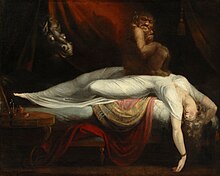
Back شلل النوم Arabic بوغطاط ARY Paralís del suañu AST Yuxu iflici Azerbaijani یوخو چولاقی AZB Сънна парализа Bulgarian বোবায় ধরা Bengali/Bangla Paràlisi del son Catalan Ké̤ṳk muôi-gūi cī CDO ئیفلیجیی خەو CKB
| Sleep paralysis | |
|---|---|
 | |
| The Nightmare by Swiss artist Henry Fuseli (1781) is thought to be a depiction of sleep paralysis perceived as a demonic visitation. | |
| Specialty | |
| Symptoms | |
| Complications | Nyctophobia |
| Duration | No more than a couple of minutes[2] |
| Risk factors |
|
| Diagnostic method | Based on description[2] |
| Differential diagnosis | |
| Treatment | |
| Frequency | 8–50%[2] |
| Deaths | None; physically harmless[3] |
Sleep paralysis is a state, during waking up or falling asleep, in which a person is conscious but in a complete state of full-body paralysis.[1][2] During an episode, the person may hallucinate (hear, feel, or see things that are not there), which often results in fear.[1][3] Episodes generally last no more than a few minutes.[2] It can recur multiple times or occur as a single episode.[1][3]
The condition may occur in those who are otherwise healthy or those with narcolepsy, or it may run in families as a result of specific genetic changes. The condition can be triggered by sleep deprivation, psychological stress, or abnormal sleep cycles. The underlying mechanism is believed to involve a dysfunction in REM sleep.[2] Diagnosis is based on a person's description. Other conditions that can present similarly include narcolepsy, atonic seizure, and hypokalemic periodic paralysis.[2] Treatment options for sleep paralysis have been poorly studied. It is recommended that people be reassured that the condition is common and generally not serious. Other efforts that may be tried include sleep hygiene, cognitive behavioral therapy, and antidepressants.[1]
Between 8% and 50% of people experience sleep paralysis at some point during their lives.[2][4] About 5% of people have regular episodes. Males and females are affected equally.[2] Sleep paralysis has been described throughout history. It is believed to have played a role in the creation of stories about alien abduction and other paranormal events.[1]
- ^ a b c d e f g h i Sharpless BA (2016). "A clinician's guide to recurrent isolated sleep paralysis". Neuropsychiatric Disease and Treatment. 12: 1761–67. doi:10.2147/NDT.S100307. PMC 4958367. PMID 27486325.
- ^ a b c d e f g h i j k l Avidan AY, Zee PC (2011). Handbook of Sleep Medicine (2nd ed.). Lippincott Williams & Wilkins. p. Chapter 5. ISBN 978-1-4511-5385-9.
- ^ a b c "Sleep paralysis". nhs.uk. 2017-10-23. Retrieved 2023-02-06.
- ^ Sharpless BA, Barber JP (October 2011). "Lifetime prevalence rates of sleep paralysis: A systematic review". Sleep Medicine Reviews. 15 (5): 311–315. doi:10.1016/j.smrv.2011.01.007. PMC 3156892. PMID 21571556.